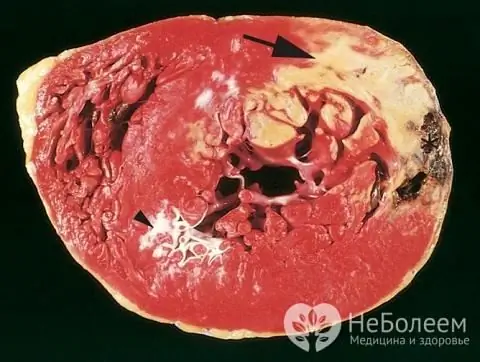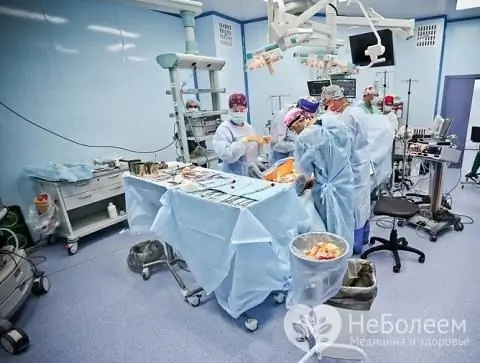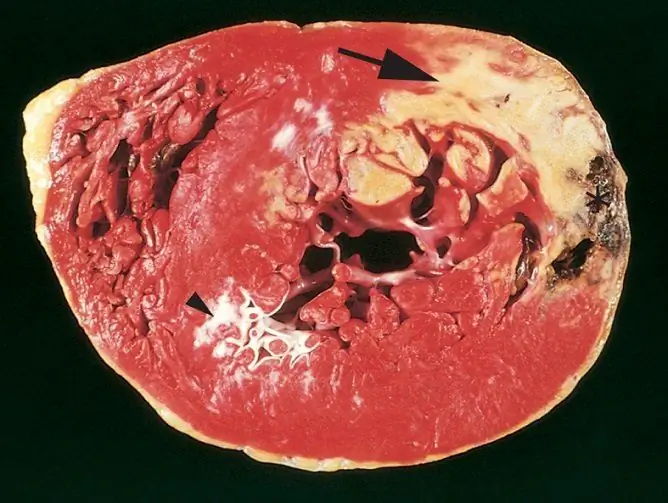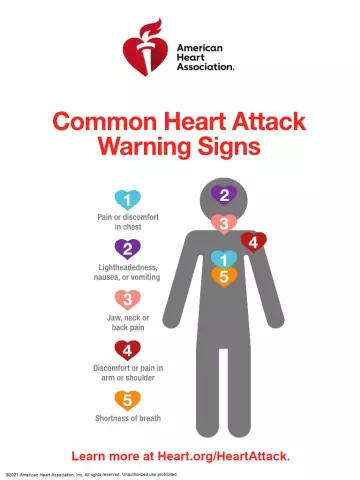- Author Rachel Wainwright [email protected].
- Public 2023-12-15 07:39.
- Last modified 2025-11-02 20:14.
Extensive heart attack
The content of the article:
- The reasons
- Symptoms of extensive myocardial infarction, typical and atypical forms
- Stages of a heart attack
- Diagnostics
- Treatment
- Complications
- Forecast
- Relapse prevention
- Video
Extensive myocardial infarction is damage to a large area of the heart muscle due to blockage of blood flow in the coronary artery.
Depending on the localization of the lesion, the disease is divided into anterior and posterior wall infarction. The occurrence of an infarction of the anterior wall is due to obstruction of the left coronary artery, and the defeat of the posterior wall is due to the right one. Anterior wall infarction is more dangerous.
How extensive myocardial damage with a heart attack looks like can be seen in the photo.

Myocardial infarction threatens the patient's life, and therefore requires immediate medical attention
So what is a massive heart attack?
The reasons
The causes that can lead to a heart attack are varied, and, as a rule, act in combination, that is, the disease is polyetiological.
The risk of developing a heart attack is influenced by: genetic predisposition, arterial hypertension, diabetes mellitus, atherosclerotic lesions of blood vessels, other pathologies of the cardiovascular system, kidney disease, malignant neoplasms, mechanical trauma, electric shock, surgery on the heart and coronary arteries.
In addition, causal factors include those that can be characterized as an inappropriate lifestyle. This is overweight, insufficient physical activity or, on the contrary, constant physical overload, chronic stress, insufficient night sleep, bad habits.
The immediate cause of a heart attack is a blockage of a coronary artery by a blood clot, embolus, or spasm.
Symptoms of extensive myocardial infarction, typical and atypical forms
The first signs with extensive myocardial damage may appear long before its onset. These are short-term cardiac pain, numbness and tingling in the right arm or shoulder, shortness of breath, weakness. These precursors appear from time to time a few weeks before a heart attack, pass quite quickly without treatment, and therefore patients often do not pay attention to them.
With extensive myocardial damage, the patient has a sharp, intense, so-called dagger pain behind the sternum and in the left half of the body (up to cardiogenic pain shock), which is not relieved by the use of anesthetic drugs and nitroglycerin. The pain is burning, pressing in nature, it is called anginal pain. A painful attack is accompanied by shortness of breath, dizziness, intermittent breathing, pallor of the skin, cold sweat, decreased blood pressure, and fear of death. In some cases, fainting occurs. This is a typical, so-called anginal form of myocardial infarction.
Atypical infarction can take different forms, which complicates the diagnosis, makes it difficult to provide timely assistance, and therefore is prognostically unfavorable. The most common atypical forms:
- hidden - there is no pain syndrome, manifested by malaise, chest discomfort. Inherent in patients with diabetes mellitus;
- asthmatic - characterized by severe shortness of breath, manifested without exertion (including in the supine position), a feeling of lack of air, palpitations;
- arrhythmic - manifested by a rapid heartbeat, heart sinking;
- gastralgic, or abdominal - pain occurs in the epigastric region, dyspeptic disorders, which is why it is often taken for an exacerbation of pancreatitis;
- cerebrovascular - characterized by dizziness, nausea, vomiting, loss of consciousness.
The main sign of a heart attack - chest pain - with atypical forms of a heart attack may be mild or completely absent.

Abdominal infarction can be mistaken for exacerbation of pancreatitis
Stages of a heart attack
In the clinical picture of a heart attack, there are five successive periods:
- Preinfarction state - there is an increase in the frequency of angina attacks, and precursors appear. Lasts from a few hours to a month.
- The most acute period is the most striking manifestation of an attack. Lasts from half an hour to six hours from the onset of the attack.
- Acute period - in the heart muscle, a site of necrosis is formed, the pain decreases, an increase in body temperature is observed, and a heart rhythm disorder. Lasts 2-10 days.
- Subacute period - a scar forms at the site of necrosis, blood pressure and heart rate gradually normalize. Lasts 4-5 weeks.
- Postinfarction period - scar density increases, the heart adapts to new conditions of functioning. Up to 6 months.
Diagnostics
Three main methods for diagnosing myocardial infarction:
- electrocardiography (ECG);
- echocardiography (echocardiography, or ultrasound of the heart);
- blood chemistry.
Later, there may be a need for coronary angiography.
Treatment
If you suspect a myocardial infarction, you must immediately call the ambulance (the best option) or independently take the patient to the hospital as soon as possible (if, for any reason, do it faster than wait for an ambulance).
Treatment of myocardial infarction is carried out in a hospital setting. The patient is shown bed rest, complete rest, a sparing diet, constant observation.
The patient is prescribed drugs from the group of narcotic analgesics, antiarrhythmics, anticoagulants (to prevent the development of blood clots), thrombolytics (to eliminate existing blood clots). With severe heart failure, respiratory disorders, cardiogenic shock, oxygen therapy is used.
In some cases, surgical treatment is indicated - coronary artery bypass grafting or balloon plastic of the coronary artery.
After the completion of the treatment, rehabilitation is started - measures aimed at adapting the body and restoring all its functions. Cardiological rehabilitation includes medical support, physiotherapy, exercise therapy, occupational therapy, spa treatment. The patient is shown regular observation by a cardiologist.
Complications
With extensive myocardial damage, the risk of complications is high.
Rupture of the heart muscle is more often observed in patients who have suffered a heart attack for the first time, usually occurs on the first day and leads to the death of the patient.
Cardiogenic shock occurs mainly with extensive damage to the anterior wall of the left ventricle against the background of damage to the coronary arteries and with necrosis of more than 40% of the left ventricular myocardium. This condition manifests itself as weakness, lethargy, increased heart rate, pallor of the skin, a sharp drop in blood pressure. In true cardiogenic shock, mortality reaches 90%.
Lung edema is manifested by moist wheezing, cough with pink foamy sputum, weakening of breathing, shortness of breath. The lethality is about 25%.
Other complications of myocardial infarction with a large lesion are: mitral valve insufficiency, pericarditis, pleurisy, thromboembolism, paralysis of the extremities, arrhythmia, sinus tachycardia, and a second attack.
The adverse consequences of a massive heart attack can develop immediately or in the long term. Preservation of the etiological factor and non-compliance by the patient with medical prescriptions increase the risk of complications.
Forecast
A large area myocardial infarction is a significant danger to human life, the chances of survival often depend on how timely medical care is provided. Mortality is 18-20%, in 40% of cases, death occurs at the pre-hospital stage. About 19% of patients with this form of myocardial infarction die over the next 5 years due to complications or recurrence of the disease.

Surgery may be necessary for extensive heart attacks
The risk of death for this pathology (low, medium, high) can be calculated using the GRACE rating scale. A large area of damage to the heart muscle, arterial hypertension, the presence of symptoms of congestive heart failure, the elderly age of the patient are among the unfavorable prognostic factors.
Relapse prevention
A second attack is highly likely to lead to paralysis or death, the risk of its occurrence is estimated at 40%, which means that people who have had a massive heart attack need active measures to prevent it.
The main role is assigned to the exclusion of etiological factors, first of all, this means a healthier lifestyle. You should give up bad habits, eat right, avoid stressful situations and excessive physical exertion, normalize body weight, perform physiotherapy exercises (at the initial stage of rehabilitation - under the supervision of a doctor), spend time in the fresh air every day. In addition, patients who have suffered a massive heart attack require lifelong supportive care and follow-up by a cardiologist.
Video
We offer for viewing a video on the topic of the article.

Anna Aksenova Medical journalist About the author
Education: 2004-2007 "First Kiev Medical College" specialty "Laboratory Diagnostics".
Found a mistake in the text? Select it and press Ctrl + Enter.






